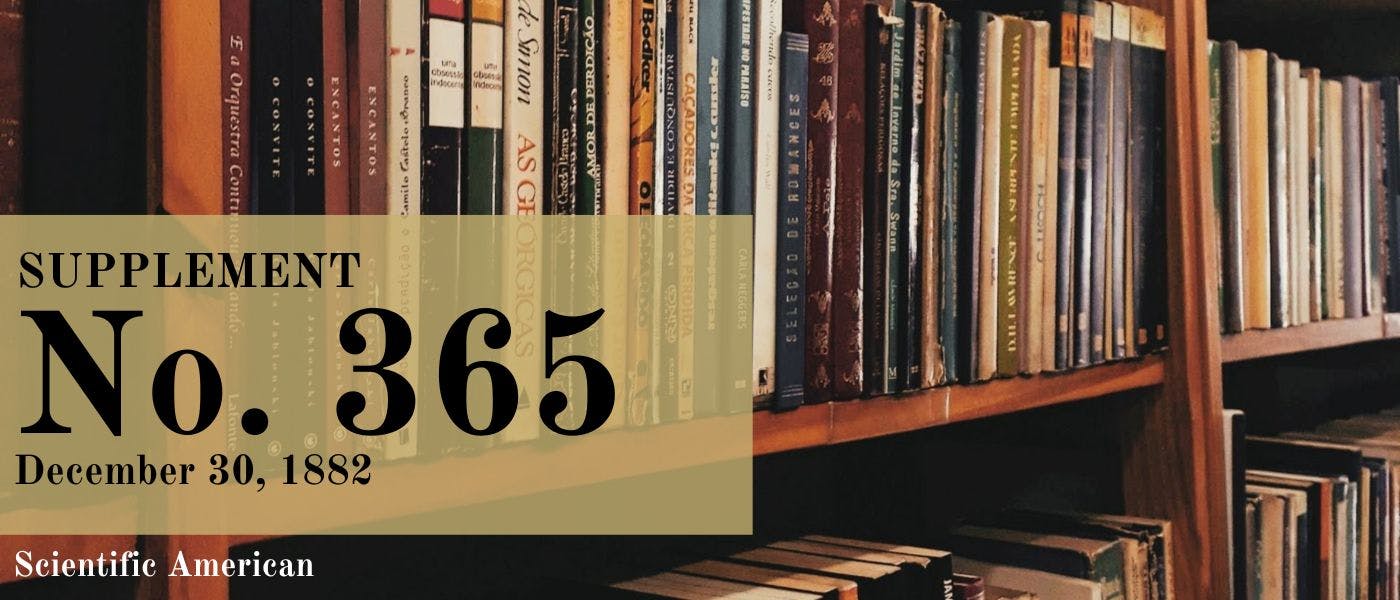Scientific American Supplement, No. 365, December 30, 1882 by Various, is part of the HackerNoon Books Series. You can jump to any chapter in this book here. ON SILICON.
ON SILICON.
It is known that platinum heated in a forge fire, in contact with carbon, becomes fusible. Boussingault has shown that this is due to the formation of a silicide of platinum by means of the reduction of the silica of the carbon by the metal. MM. P. Schützenberger and A. Colson have produced the same phenomenon by heating to white heat a slip of platinum in the center of a thick layer of lampblack free from silica.
The increase in weight of the metal and the augmentation of its fusibility were found to be due, in this case also, to a combination with silicon. As the silicon could not come directly from the carbon which surrounded the platinum, MM. Schützenberger and Colson have endeavored to discover under what form it could pass from the walls of the crucible through a layer of lampblack several centimeters in thickness, in spite of a volatility amounting to almost nothing under the conditions of the experiment. They describe the following experiments as serving to throw some light upon the question:
-
A thin slip of platinum rolled in a spiral is placed in a small crucible of retort carbon closed by a turned cover of the same material. This is placed in a second larger crucible of refractory clay, and the intervening space filled with lampblack tightly packed. The whole is then heated to white heat for an hour and a half in a good wind furnace. After cooling, the platinum is generally found to have been fused into a button, with a marked increase in weight due to taking up silicon, which has penetrated in the form of vapor through the walls of the interior crucible.
-
If, in the preceding experiment, the lampblack be replaced by a mixture of lampblack and rutile in fine powder, the slip of platinum remains absolutely intact, and does not change in weight. Thus the titaniferous packing recommended by Sainte-Claire Deville for preventing the access of nitrogen in experiments at high temperatures also prevents the passage of silicon. A mixture of carbon and finely divided iron is, on the contrary, ineffectual. These facts seem to indicate that nitrogen plays a part in the transportation of the silicon, as this is only prevented by the same means made use of in order to prevent the passage of nitrogen.
-
The volatility of free silicon at a high temperature is too slight to account for the alteration of the platinum at a distance. This can be shown by placing several decigrammes of crystallized silicon on the bottom of a small crucible of retort carbon, covering the silicon with a small flat disk of retort carbon upon which is placed the slip of platinum. The crucible, closed by its turned cover, is then enveloped in a titaniferous packing and kept at a brilliant white heat for an hour and a half. The metal is found to have only very slightly increased in weight, and its properties remain unaltered. This experiment was repeated several times with the same result. If, however, the crystallized silicon be replaced by powdered calcined silica, the platinum, placed upon the carbon disk, fuses and increases in weight, while the silica loses weight. The theory of these curious phenomena is very difficult to establish on account of the high temperatures which are necessary for their manifestation, but it may be concluded, at present, that nitrogen and probably oxygen also play some part in the transportation of the silicon across the intervening space, and that the carbosilicious compounds recently described by MM. Schützenberger and Colson also take part in the phenomenon.—Comptes Rendus, xciv., 1,710.—Amer. Chem. Journal.
About HackerNoon Book Series: We bring you the most important technical, scientific, and insightful public domain books.
This book is part of the public domain. Various (2006). Scientific American Supplement, No. 365, December 30, 1882. Urbana, Illinois: Project Gutenberg. Retrieved https://www.gutenberg.org/cache/epub/18763/pg18763-images.html
This eBook is for the use of anyone anywhere at no cost and with almost no restrictions whatsoever. You may copy it, give it away or re-use it under the terms of the Project Gutenberg License included with this eBook or online at www.gutenberg.org, located at https://www.gutenberg.org/policy/license.html.

